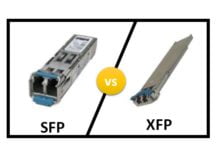SFP is abbreviation for Small Form-factor Pluggable transceiver. The SFP transceiver is compact and hot-pluggable module and widely used in the field of Data Communication. This transceiver acts as an interface between a networking device and Fiber/Copper cable. This networking device may be wide array of devices like switch, TAP, Firewall, repeater, router etc. SFP Transceiver Module can be regarded as the upgraded version of GBIC (SC fiber optic interfaces). SFP has LC type interface and the main body size of SFP is only about half of GBIC. SFP can accommodate different cable termination types like UTP Copper, Single Mode Fiber , Multimode Fiber etc.
Related – STP Interview Questions
BELOW ARE SOME OF KEY BENEFITS ONE CAN HARNESS OUT OF SFP TRANSCEIVERS –
- SFP transceivers are hot-swappable and can be replaced/removed without disrupting the running device or any reboot requirement.
- SFPs are Compatible with many communication standards like Ethernet, SONET, and Fiber Channel etc.
- SFPs have flexibility to allow design modification to the network or phased changes in network. For e.g. – In 1st phase we may require temporary termination of WAN Links on Fiber cable , while in 2nd phase Fiber link may not be required and we may remove the SFP from device and reuse the same SFP into other LAN Networking device like Core Switch to Distribution Switch connectivity between Floors etc.
- SFP transceiver modules make the fiber optic or Ethernet network easier to upgrade or maintain since users can replace a single SFP module during the process instead of replace the whole board with many modules on it.
- Digital optical monitoring (DOM) is a feature set which allow customers to monitor real-time parameters of the SFP like Optical inputs and output power, laser bias, and supply voltage. This helps in making day to day operations simpler and controllable.
- SFP is more space saving than GBIC (SFP may be called upgraded version of GBIC), since the former has only half the size of the latter.
- SFP cage is surface mounted to the PCB assembly to simply accept the transceiver. This not only provides simple replacement and reconfiguration, but also eliminates further manufacturing steps and therefore reduces cost.
- SFPs have array of termination options like UTP Copper, Single mode and Multi-mode etc. providing the capability for both long and short distance communication.
ABOUT THE AUTHOR

You can learn more about her on her linkedin profile – Rashmi Bhardwaj



